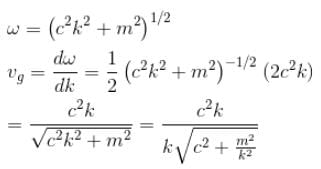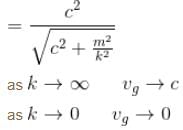Physics Exam > Physics Questions > The dispersion law for a certain type of wave...
Start Learning for Free
The dispersion law for a certain type of wave motion is ω = (c2k2 + m2)1/2 where ω is the angular frequency, k is the magnitude of the propagation vector and c, m are constants. The group velocity of these waves approaches :
- a)vg → c as k → ∞
- b)vg → 0 as k → ∞
- c)vg → 0 as k → 0
- d)vg → c as k → 0
Correct answer is option 'A,C'. Can you explain this answer?
| FREE This question is part of | Download PDF Attempt this Test |
Verified Answer
The dispersion law for a certain type of wave motion is ω= (c2k2...


Most Upvoted Answer
The dispersion law for a certain type of wave motion is ω= (c2k2...
The relationship between the wave's frequency (f) and its wavenumber (k). It describes how the wave speed changes with the wave's frequency or wavelength.
In general, the dispersion law can be expressed as:
ω = ω(k)
where ω is the angular frequency of the wave and k is the wavenumber.
For different types of wave motion, the dispersion law may take different forms. Some common examples include:
1. Linear dispersion: In this case, the dispersion law is given by ω = ck, where c is the phase speed of the wave. This means that the wave's frequency is directly proportional to its wavenumber.
2. Nonlinear dispersion: In some cases, the dispersion law may not be linear. The relationship between ω and k can be a more complex function, involving higher powers of k or non-linear terms. This is particularly common in waves that exhibit wave-breaking or wave-steepening behavior, such as ocean waves.
3. Anomalous dispersion: In certain materials or systems, the dispersion law may have unusual behavior. This is known as anomalous dispersion. For example, in some cases, the wave speed may decrease as the frequency increases, leading to a negative dispersion or dispersion inversion.
The specific form of the dispersion law depends on the properties of the medium or system in which the wave is propagating. Different materials or systems can exhibit different dispersion characteristics, resulting in waves with different relationships between frequency and wavenumber.
In general, the dispersion law can be expressed as:
ω = ω(k)
where ω is the angular frequency of the wave and k is the wavenumber.
For different types of wave motion, the dispersion law may take different forms. Some common examples include:
1. Linear dispersion: In this case, the dispersion law is given by ω = ck, where c is the phase speed of the wave. This means that the wave's frequency is directly proportional to its wavenumber.
2. Nonlinear dispersion: In some cases, the dispersion law may not be linear. The relationship between ω and k can be a more complex function, involving higher powers of k or non-linear terms. This is particularly common in waves that exhibit wave-breaking or wave-steepening behavior, such as ocean waves.
3. Anomalous dispersion: In certain materials or systems, the dispersion law may have unusual behavior. This is known as anomalous dispersion. For example, in some cases, the wave speed may decrease as the frequency increases, leading to a negative dispersion or dispersion inversion.
The specific form of the dispersion law depends on the properties of the medium or system in which the wave is propagating. Different materials or systems can exhibit different dispersion characteristics, resulting in waves with different relationships between frequency and wavenumber.

|
Explore Courses for Physics exam
|

|
Similar Physics Doubts
The dispersion law for a certain type of wave motion is ω= (c2k2 + m2)1/2 whereωis the angular frequency,kis the magnitude of the propagation vector andc,mare constants. The group velocity of these waves approaches :a)vg→ c as k→ ∞b)vg→ 0 as k→ ∞c)vg→ 0 as k→ 0d)vg→ c as k→ 0Correct answer is option 'A,C'. Can you explain this answer?
Question Description
The dispersion law for a certain type of wave motion is ω= (c2k2 + m2)1/2 whereωis the angular frequency,kis the magnitude of the propagation vector andc,mare constants. The group velocity of these waves approaches :a)vg→ c as k→ ∞b)vg→ 0 as k→ ∞c)vg→ 0 as k→ 0d)vg→ c as k→ 0Correct answer is option 'A,C'. Can you explain this answer? for Physics 2024 is part of Physics preparation. The Question and answers have been prepared according to the Physics exam syllabus. Information about The dispersion law for a certain type of wave motion is ω= (c2k2 + m2)1/2 whereωis the angular frequency,kis the magnitude of the propagation vector andc,mare constants. The group velocity of these waves approaches :a)vg→ c as k→ ∞b)vg→ 0 as k→ ∞c)vg→ 0 as k→ 0d)vg→ c as k→ 0Correct answer is option 'A,C'. Can you explain this answer? covers all topics & solutions for Physics 2024 Exam. Find important definitions, questions, meanings, examples, exercises and tests below for The dispersion law for a certain type of wave motion is ω= (c2k2 + m2)1/2 whereωis the angular frequency,kis the magnitude of the propagation vector andc,mare constants. The group velocity of these waves approaches :a)vg→ c as k→ ∞b)vg→ 0 as k→ ∞c)vg→ 0 as k→ 0d)vg→ c as k→ 0Correct answer is option 'A,C'. Can you explain this answer?.
The dispersion law for a certain type of wave motion is ω= (c2k2 + m2)1/2 whereωis the angular frequency,kis the magnitude of the propagation vector andc,mare constants. The group velocity of these waves approaches :a)vg→ c as k→ ∞b)vg→ 0 as k→ ∞c)vg→ 0 as k→ 0d)vg→ c as k→ 0Correct answer is option 'A,C'. Can you explain this answer? for Physics 2024 is part of Physics preparation. The Question and answers have been prepared according to the Physics exam syllabus. Information about The dispersion law for a certain type of wave motion is ω= (c2k2 + m2)1/2 whereωis the angular frequency,kis the magnitude of the propagation vector andc,mare constants. The group velocity of these waves approaches :a)vg→ c as k→ ∞b)vg→ 0 as k→ ∞c)vg→ 0 as k→ 0d)vg→ c as k→ 0Correct answer is option 'A,C'. Can you explain this answer? covers all topics & solutions for Physics 2024 Exam. Find important definitions, questions, meanings, examples, exercises and tests below for The dispersion law for a certain type of wave motion is ω= (c2k2 + m2)1/2 whereωis the angular frequency,kis the magnitude of the propagation vector andc,mare constants. The group velocity of these waves approaches :a)vg→ c as k→ ∞b)vg→ 0 as k→ ∞c)vg→ 0 as k→ 0d)vg→ c as k→ 0Correct answer is option 'A,C'. Can you explain this answer?.
Solutions for The dispersion law for a certain type of wave motion is ω= (c2k2 + m2)1/2 whereωis the angular frequency,kis the magnitude of the propagation vector andc,mare constants. The group velocity of these waves approaches :a)vg→ c as k→ ∞b)vg→ 0 as k→ ∞c)vg→ 0 as k→ 0d)vg→ c as k→ 0Correct answer is option 'A,C'. Can you explain this answer? in English & in Hindi are available as part of our courses for Physics.
Download more important topics, notes, lectures and mock test series for Physics Exam by signing up for free.
Here you can find the meaning of The dispersion law for a certain type of wave motion is ω= (c2k2 + m2)1/2 whereωis the angular frequency,kis the magnitude of the propagation vector andc,mare constants. The group velocity of these waves approaches :a)vg→ c as k→ ∞b)vg→ 0 as k→ ∞c)vg→ 0 as k→ 0d)vg→ c as k→ 0Correct answer is option 'A,C'. Can you explain this answer? defined & explained in the simplest way possible. Besides giving the explanation of
The dispersion law for a certain type of wave motion is ω= (c2k2 + m2)1/2 whereωis the angular frequency,kis the magnitude of the propagation vector andc,mare constants. The group velocity of these waves approaches :a)vg→ c as k→ ∞b)vg→ 0 as k→ ∞c)vg→ 0 as k→ 0d)vg→ c as k→ 0Correct answer is option 'A,C'. Can you explain this answer?, a detailed solution for The dispersion law for a certain type of wave motion is ω= (c2k2 + m2)1/2 whereωis the angular frequency,kis the magnitude of the propagation vector andc,mare constants. The group velocity of these waves approaches :a)vg→ c as k→ ∞b)vg→ 0 as k→ ∞c)vg→ 0 as k→ 0d)vg→ c as k→ 0Correct answer is option 'A,C'. Can you explain this answer? has been provided alongside types of The dispersion law for a certain type of wave motion is ω= (c2k2 + m2)1/2 whereωis the angular frequency,kis the magnitude of the propagation vector andc,mare constants. The group velocity of these waves approaches :a)vg→ c as k→ ∞b)vg→ 0 as k→ ∞c)vg→ 0 as k→ 0d)vg→ c as k→ 0Correct answer is option 'A,C'. Can you explain this answer? theory, EduRev gives you an
ample number of questions to practice The dispersion law for a certain type of wave motion is ω= (c2k2 + m2)1/2 whereωis the angular frequency,kis the magnitude of the propagation vector andc,mare constants. The group velocity of these waves approaches :a)vg→ c as k→ ∞b)vg→ 0 as k→ ∞c)vg→ 0 as k→ 0d)vg→ c as k→ 0Correct answer is option 'A,C'. Can you explain this answer? tests, examples and also practice Physics tests.

|
Explore Courses for Physics exam
|

|
Suggested Free Tests
Signup for Free!
Signup to see your scores go up within 7 days! Learn & Practice with 1000+ FREE Notes, Videos & Tests.


















